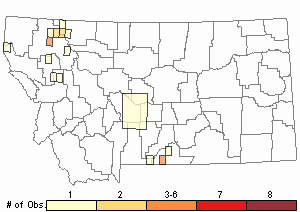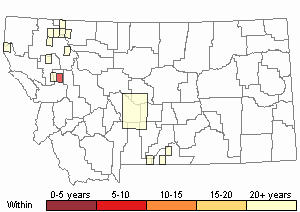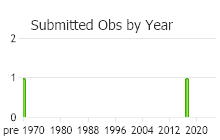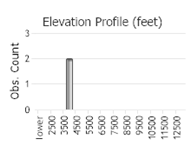View in other NatureServe Network Field Guides
NatureServe
Montana
Utah
Wyoming
Idaho
Wisconsin
British Columbia
South Carolina
Yukon
California
New York
Bordered Mnium Moss - Mnium marginatum
General Description
Plants: Acrocarpous (Vitt 1988), growing in open clumps of erect shoots. Stems unbranched (Crum and Anderson et al. 1981), reddish to russet, mostly 2-3 cm tall, rarely to 6 cm (FNA 2014), possessing a central strand (Lawton 1971); macronemata mostly below (FNA 2014).
Leaves: Moderate to deep green, twisted, bent or curved when dry (FNA 2014), spreading when wet, 1-1.5 mm in width (Lawton 1971), 2-4 mm in length, seldom reaching 5 mm, the upper leaves much larger (FNA 2014) and more crowded than those below (Crum and Anderson et al. 1981), elliptic, sometimes with ovate tendencies, to ovate with the leaf edges occasionally running somewhat parallel, seldom slender, ending in an acute or seldom obtuse to curved leaf tip, sometimes forming an acumen, but rarely developing an apiculus or cusp; base extending well-down the stem; margins flat, russet, dentate in the distal half to sometimes a little further down the margin, the teeth varying in size and sharpness, mostly in pairs; costa nearly reaching to extending beyond the leaf tip, seldom with several, dull teeth on the upper part of the dorsal surface (FNA 2014).
Leaf Cells: Margins mostly of 2 cell-layers, seldom more, the cells long and narrow in 2 to seldom 4 rows (FNA 2014), forming a border, the marginal teeth of 1 cell (Lawton 1971); medial cells of the lamina about as wide as long or slightly elongated, a little larger toward the center than near the margins, obliquely- or longitudinally-rowed (FNA 2014), with wall-angles thickened (Lawton 1971).
Phenology
Fruit ripens in the last part of spring (FNA 2014).
Diagnostic Characteristics
M. marginatum occasionally has leaves as slender as those of the similar M. lycopodioides, making the two species difficult to distinguish, particularly when sterile. M. lycopodioides has a shorter beak on the calyptra and is dioicous; M. marginatum is seldom dioicous (FNA 2014).
Range Comments
North American Range
Nearly throughout Canada and the US. AK to NU, BC to NL and NS, s to CA, AZ, NM, NE, AR, AL, and GA (except OR, IN, and SC) (FNA 2014). Known in Montana from Carbon, Cascade, Deer Lodge, Fallon, Flathead, Gallatin, Glacier, Granite, Lake, Lincoln, Missoula, Park, Powell, Ravalli, and Sanders Counties (Elliott and Pipp 2016).
Observations in Montana Natural Heritage Program Database
Number of Observations: 27
(Click on the following maps and charts to see full sized version)
Map Help and Descriptions
Relative Density

Recency



 (Observations spanning multiple months or years are excluded from time charts)
(Observations spanning multiple months or years are excluded from time charts)
Habitat
Damp soil and humus in forests and near watercourses (Lawton 1971), protected bluffs (FNA 2014), and seldom decomposing wood (Crum and Anderson et al. 1981), frequently inhabiting calcareous areas. Occurring from lowlands to about 9840 feet (Lawton 1971).
Reproductive Characteristics
Archegonia and antheridia mostly mingling in the same cluster, seldom dioicous. Seta solitary (FNA 2014), 20-30 mm tall (Lawton 1971). Capsule sometimes reaching 4 mm in length, ochre (FNA 2014), with a short neck; stomata sunken with guard cells visible (Lawton 1971), occurring in the neck (Crum and Anderson et al. 1981); exostome russet or sometimes more yellow (FNA 2014), papillose; endostome segments with wide perforations on the keel and groups of 2-3 knobby cilia. Calyptra draping like a hood (Lawton 1971).
Stewardship Responsibility
References
- Literature Cited AboveLegend:
 View Online Publication
View Online Publication Crum, H.A. and L.E. Anderson. 1981. Mosses of Eastern North America. 2 volumes. Columbia University Press, New York. 1328 pp.
Crum, H.A. and L.E. Anderson. 1981. Mosses of Eastern North America. 2 volumes. Columbia University Press, New York. 1328 pp. Elliott, J.C. and A.K. Pipp. 2018. A Checklist of Montana Mosses (1880-2018). Updated 3 January, 2020. Montana Natural Heritage Program, Helena, Montana. 73 pp.
Elliott, J.C. and A.K. Pipp. 2018. A Checklist of Montana Mosses (1880-2018). Updated 3 January, 2020. Montana Natural Heritage Program, Helena, Montana. 73 pp. Flora of North America Editorial Committee, eds. 2014. Flora of North America North of Mexico. Volume 28. Bryophytes: Mosses, Part 2. Oxford University Press, Inc., NY. xxi + 702 pp.
Flora of North America Editorial Committee, eds. 2014. Flora of North America North of Mexico. Volume 28. Bryophytes: Mosses, Part 2. Oxford University Press, Inc., NY. xxi + 702 pp. Lawton, E. 1971. Moss Flora of the Pacific Northwest. Hattori Botanical Laboratory. Japan: Yamabuki-cho, Shinjuku-ku, Tokyo. 362 pages plus appendices.
Lawton, E. 1971. Moss Flora of the Pacific Northwest. Hattori Botanical Laboratory. Japan: Yamabuki-cho, Shinjuku-ku, Tokyo. 362 pages plus appendices. Vitt, D. J. Marsh, and R. Bovey. 1988. Mosses, Lichens & Ferns of Northwest North America. Seattle, WA: University of Washington Press. 296 p.
Vitt, D. J. Marsh, and R. Bovey. 1988. Mosses, Lichens & Ferns of Northwest North America. Seattle, WA: University of Washington Press. 296 p.
- Additional ReferencesLegend:
 View Online Publication
View Online Publication
Do you know of a citation we're missing? Elliot, J. C. 1993. Second checklist of Montana mosses. Unpublished report. U.S. Forest Service, Region 1. Missoula, MT. 45 pp.
Elliot, J. C. 1993. Second checklist of Montana mosses. Unpublished report. U.S. Forest Service, Region 1. Missoula, MT. 45 pp. Flowers, S. 1973. Mosses: Utah and the West. Brigham Young University, Provo, Utah. 567 p.
Flowers, S. 1973. Mosses: Utah and the West. Brigham Young University, Provo, Utah. 567 p. Lawton, E. 1971. Keys for the Identification of the Mosses on the Pacific Northwest. Reprinted from 'Moss Flora of the Pacific Northwest'. Published as Supplement No. 2 of the Journal of the Hattori Botanical Laboratory. Nichinan, Miyazaki, Japan. 66 pp.
Lawton, E. 1971. Keys for the Identification of the Mosses on the Pacific Northwest. Reprinted from 'Moss Flora of the Pacific Northwest'. Published as Supplement No. 2 of the Journal of the Hattori Botanical Laboratory. Nichinan, Miyazaki, Japan. 66 pp. Malcolm, B., N. Malcolm, J. Shevock, and D. Norris. 2009. California Mosses. Nelson, New Zealand: Micro-Optics Press. 430 pp.
Malcolm, B., N. Malcolm, J. Shevock, and D. Norris. 2009. California Mosses. Nelson, New Zealand: Micro-Optics Press. 430 pp. Smith, A.J.E. 1980. The Moss Flora of Britain and Ireland. Cambridge University Press, Cambridge. 705 pp.
Smith, A.J.E. 1980. The Moss Flora of Britain and Ireland. Cambridge University Press, Cambridge. 705 pp.
- Web Search Engines for Articles on "Bordered Mnium Moss"





